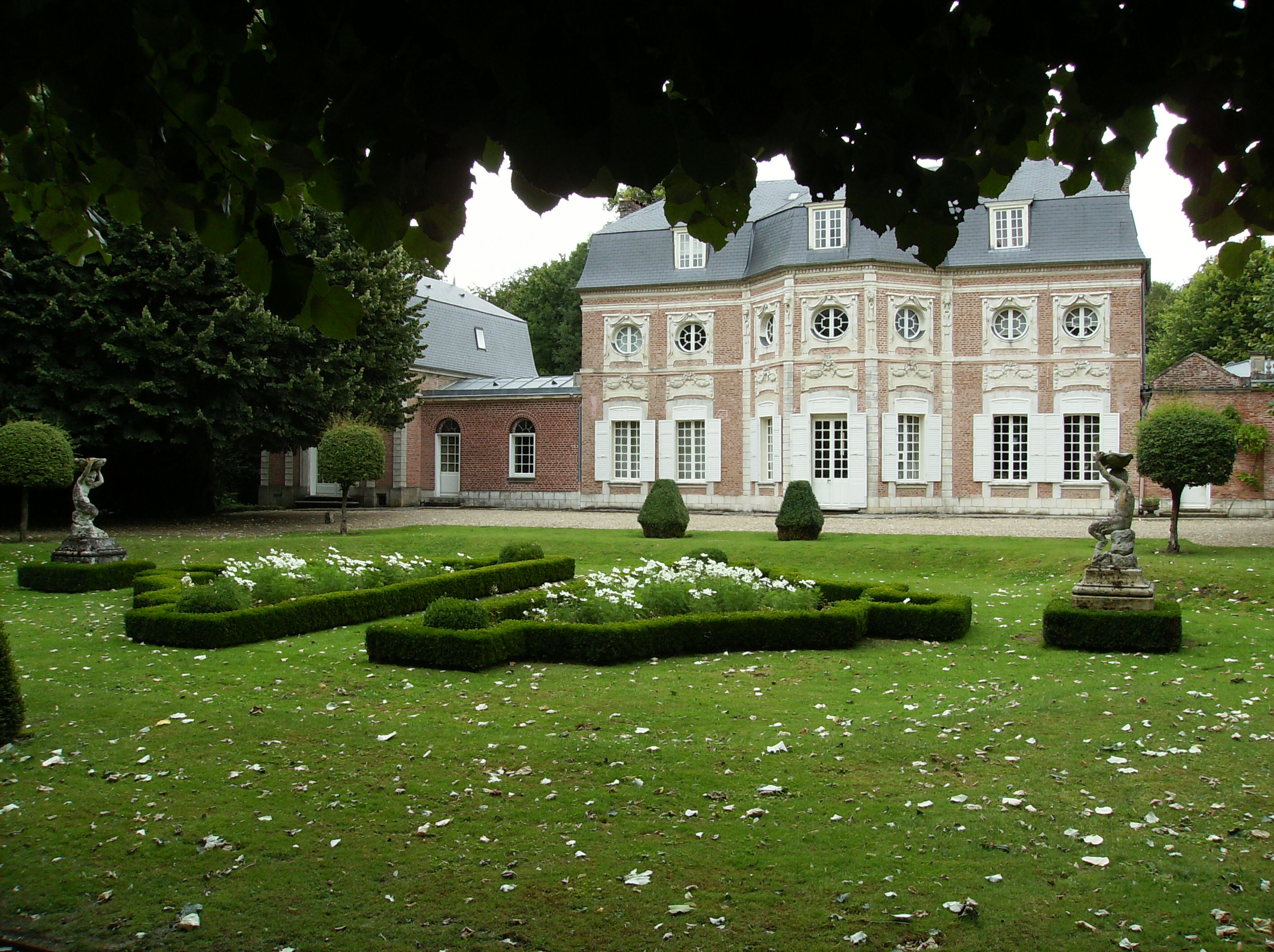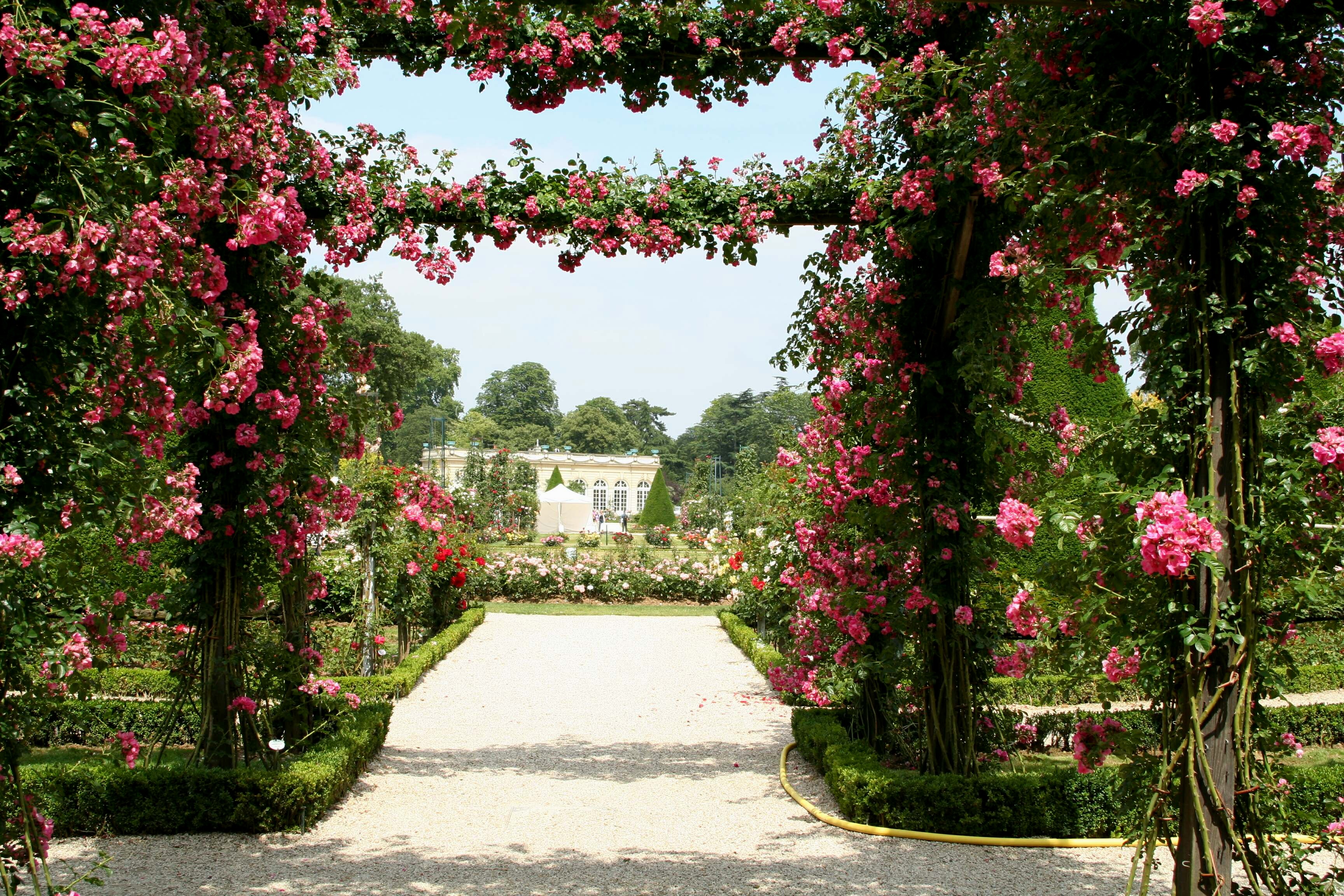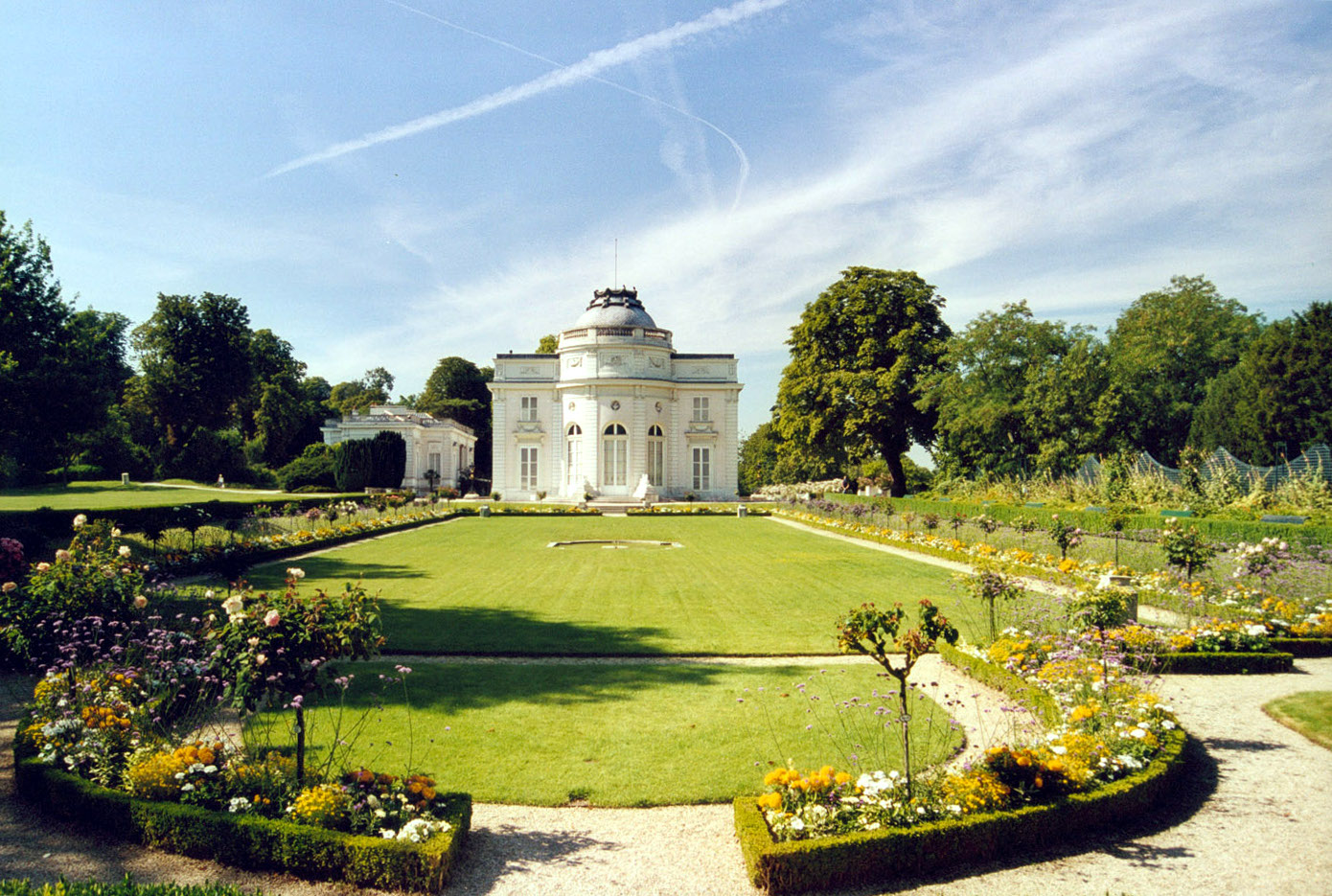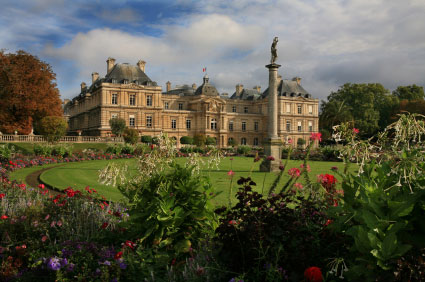"One of the greatest cultural buildings of the nineteenth century to use iron in a prominent, visible way was unquestionably the Bibliotheque Ste.-Genevieve in Paris, designed by Henri Labrouste and built in 1842-50. The large (278 by 69 feet) two-storied structure filling a wide, shallow site is deceptively simple in scheme: the lower floor is occupied by stacks to the left, rare-book storage and office space to the right, with a central vestibule and stairway leading to the reading room which fills the entire upper story. The ferrous structure of this reading room—a spine of slender, cast-iron Ionic columns dividing the space into twin aisles and supporting openwork iron arches that carry barrel vaults of plaster reinforced by iron mesh—has always been revered by Modernists for its introduction of high technology into a monumental building."(Marvin Trachtenberg and Isabelle Hyman. Architecture: from Prehistory to Post-Modernism. p.478.)
Architecture of Paris
Basilique du Sacré-Cœur
Set upon the highest point in Paris, Monmarte is home to the Basilique du Sacré-Cœur (Basilica of the Sacred Heart). Sacré-Cœur was built in the 19th century however is still a highly active Roman Catholic church. Being a prominent landmark, Sacré-Cœur - let alone the artistic haven, Monmarte - adds to the tremendous diversity seen in the architectural elements of Paris. Devout Parisian Catholics pay weekly homages to Sacré-Cœur, however it also is a point of pilgrimage to many people around the world. Its nationalistic references, including France's national saints as well as the province of Savoy. This basilica is a place of worship, but also is worshiped by architects and Parisians - for bringing such radiant beauty to the City of Light, Paris.
The Basilique du Sacré-Cœur was designed by Paul Abadie in a Romanesque-Byzantine architectural style in 1873. According to Holly Hayes of Sacred Destinations, "The Sacré-Coeur was inspired by St-Front in Perigueux (Dordogne), a multi-domed Romanesque church the architect had recently restored. The triple-arched portico is surmounted by two bronze equestrian statues of France's national saints, Joan of Arc and King Saint Louis IX, designed by Hippolyte Lefebvre. Even the great bell, the Savoyarde, has nationalist references: Savoy was annexed to France in 1860. Cast in Annecy in 1895, it is one of the world's heaviest bells at 19 tons."
Despite its outward radiating appearance, the main portal has grand bronze doors with foliage designs which leads into a dim and rather gloomy sanctuary with heavy and almost overly ornate details. The stylized golden mosaics glowing from apse however remind us that this isn't just any basilica, it is the Sacré-Cœur. The floor plan is a typical basilica layout with an equal-armed Greek cross and a large dome (83m high) over the crossing. A notable aspect of the sanctuary, despite the heavenly atmosphere already created, a huge choir loft with 11 tall round arches support a looming barrel vault. In the choir is a large mosaic of Christ with a flaming heart, flanked by the Archangel Michael and Joan of Arc on the right and Louis XVI and his family on the left.
Sacré-Cœur is an extrordinairy architectural feat. It is a massive building that has managed to keep its beaming white color even in the polluted air of a big city like Paris. This radiancy can be attributed to the Château-Landon stones which were used for the construction of the basilica. These stones act like a bleaching agent when it rains, as it seems they react to the water and secrete calcite.
Sources:
Château de Bagatelle
Château de Bagatelle, Paris. (Source)
Built in 1720, Château de Bagatelle was originally a mere three-room hunting lodge. The Château had neither kitchen nor bedroom and only a flat terrace roof. It can now be found among the enchanted gardens of Bois de Boulonge, Paris. As it was the only building not destroyed in World War II, it is the only remaining château in the gardens. Despite the damage done to the roof, it has been renovated since then. It stands today as a charming 18th-century château in the northwestern part of the Bois de Boulogne gardens. From the renovation, and work that has been done on the Château over the years, the dining room, winter living-room, as well as the library and music room can be visited.
Château de Bagatelle, Paris. (Source)
Château de Bagatelle is known for the exquisite gardens which encompass the property. The 'Parc de Bagatelle' is laid out in the Anglo-Chinese style and was designed by Thomas Blaikie. What can be found in this Anglo-Chinese inspired style ranges from waterfalls, to Pagodas, and paths framed by rosebushes and linden trees. Surrounding the peaceful lake of the 'Parc de Bagatelle', there are orchards and hidden groves - adding beauty and mystique to the elegant Château. A multitude of French Festivals. Concerts, exhibitions and cultural events are held in the fifty-nine acre Bagatelle gardens and castle annually. Most notable is the the Festival de Chopin à Paris, which was established in 1983, and is held each June and July at the Orangerie de Bagatelle. Voltaire, Saint Säens, Sedaine, Perronneau and Mrs de La Platière were some of the most famous guests at the Château de Bagatelle.
Château de Bagatelle, Paris. (Source)
Not very much can be said about the original exterior design as is has been changed many times during renovation and redecorating since the 18th century. However, what is known about the original Château has been very articulately described by writer, Andrew Ayers;
In Jeannine Bergeron's blog on the architecture, decor and gardens of Paris she discusses her personal experience at the the Château. Bergeron describes it as "a neoclassic architectural jewel...remind(s) me of (a) music box...perfectly square, sweet, feminine and filled with treasures. The interior of the Bagatelle is well-preserved and beautifully outfitted with 18th and 19th century furniture, porcelain, and drawings. The décor is in soft shades of celadon, blue, pink and gray. Straight lines and pastel colors marked the beginning of the neoclassic period in France.
Un Paon de Bagatelle (Source)
One of the most notable things about the Chateau is the amazing trompe l’oeil painting. Blue skies, billowing clouds, and cherubs painted by famous artist Hubert Robert create a light and cheerful space. The trompe l’oeil coffered ceiling in the music room is remarkable.
The dining room was fully furnished and beautiful as well. The table was laid with Sevres porcelain, 19th century crystal, and silver candelabra. A walnut rafraichissoir sat in the corner. These little tables were popular in the 19th century, as they were used to hold wine needed to refresh beverages during a meal."
Château de Bagatelle, Paris. (Source)
Palais du Luxembourg et Jardin
"Building well has three conditions: firmness, commodity, and delight." Vitruvius  |
| Palais et Jardin du Luxembourg |
 |
| Palais du Luxembourg |
The Luxembourg Palace in Paris was commissioned in 1615 by Marie de Médicis. Designed after her childhood home Pitti Palaco in Florence, Italy, the Luxembourg Palace remains true to classical 17th century French architecture. The architect, Salomon de Brosse, in addition to Alphonse de Gisors and Jacques Le Mercier followed a typical layout used in designing palaces and manors. Typically seen in French palaces, the wings of the building would be surrounding a main court, with the chief living quarters and chapel facing a garden.
Salomon de Brosse designed the Palais du Luxembourg in the French Baroque style, characterized through a new rhetorical and theatrical fashion. This architecture style first began to surface at the start of the 17th century. During the reigns of Louis XIII, Louis XIV and Louis XV this style continued to flourish and expand. Although Marie Medici This style is expressed primarily through de Brosse's use of lavish embellishments, extravagant ornamentation and bold contrasts. The Palais du Luxembourg embodies stylistic elements of Baroque architectural style through its explorations of form, light and shadow. In addition to these aspects, an external façade often characterized by a dramatic central projection can also be seen very prominently in the Palais.
Sources:
The Eiffel Tower & Galerie des Machines
"The first principle of architectural beauty is that
the essential lines of a construction be determined by
a perfect appropriateness to its use." Gustave Eiffel
Today, the Eiffel Tower is a international icon of Paris. In all of its glory, it can be seen both day and night from almost all parts of the city. The Eiffel Tower caused a sensation in its own time as the tallest structure in the world and as a milestone in iron construction as well as engineering - as it was the first building in almost 5,000 years to surpass the height of the Great Pyramid. Research engineers, Maurice Koechlin and Emile Nouguier, worked under the guidance of Gustave Eiffel, and constructed the Tower in collaboration with the architect Stephan Suavestre. The Eiffel Tower is piece of art, a graceful and functional structure made with iron lattice pylon. It towers over the city at 1,020 feet (312 meters).
With the celebrations surrounding the Centennial of the French Revolution approaching, the Tower was also intended to spark French nationalism and pride. Similar to other momentous monuments, the Tower inevitably was criticized and slandered. A fair number of well-respected mainstream French artists, writers and intellectuals complained in 1887 that the Tower would be a "monstrous symbol of the craven machine age" that would destroy the integrity of Paris. A petition of more than three hundred names in opposition of the Tower's erection included: Guy de Maupassant, Émile Zola, Charles Garnier (architect of the Opéra Garnier), and Alexandre Dumas. The petition read,
"We, the writers, painters, sculptors, architects and lovers of the beauty of Paris, do protest with all our vigour and all our indignation, in the name of French taste and endangered French art and history, against the useless and monstrous Eiffel Tower."
Despite the petitioners, reputable names such as Rousseau, Utrillo, Chagall, and Delaunay all were fascinated and in admiration of Eiffel. While the idea of building a expansive iron structure had been circulating among architects for some time, the execution of this monumental tower was extraordinary. The idea of the Tower first surfaced in 1884 in order to mark the Exposition of 1889 which was to be held in Paris. From the mid-1800s Expositions were held throughout Europe and America in order to bring attention to the architectural developments in style, construction and achievements. The Eiffel Tower is certainly one of the most well known, as well as still remaining, representations of the World Fair Expositions throughout the 19th century. It served as part of the grand entrance into where the Exposition was being held, which stretched about a kilometer and included Champs de Mars, the Invalides and parts of the Seine River.
 |
| A view of the Exposition Universelle (1889 - Paris, France) |
A major part of the Exposition was the Galerie des Machines, designed by architect Ferdinand Dutert and engineer Victor Contamin. This building was also monumental in size, beauty as well as despite the aesthetic qualities was also highly functional. The Galerie des Machines was built principally of iron and glass, and reached a colossal length of 1,270 feet. By the end of the 19th century, the grandiose proportions of this display hall proved to be the largest unobstructed floor area of any building. Without doubt, the Galerie des Machines proved to be the ideal setting in which to show the world the massive engines, transformers, dynamos, and other engineering wonders of the age.
Despite being constructed primarily of iron, the Galerie des Machines exhibited an apparent lightness executed through the way in which the bases of the supporting arches touched the ground. This structural innovativeness, defied the "conventional, rational notion that the base was the principal load-bearing component of any structure; here that role was seemingly reversed. The hinges allowed small movements between the foot of the frames and the foundation but made the arches statically determinate. Thus, stresses and reactions at the supports could be calculated beforehand and were only slightly influenced by movements of the supports or thermally induced dimensional variations."
While the Eiffel Tower managed to escape the destruction which it was to face after its twenty year lease had expired, the Galerie des Machines was not as fortunate and was destroyed in 1910. The Eiffel Tower has come to represent the time in which it was built: the Belle Époque. "This identification of the object with its moment of origin has lasted because of its positive association as a time when Paris played a leading role in creating a certain kind of modern, leisure-oriented spectacular urban culture. Its enduring significance as an icon highlights the great tension between the positive French embrace of progress and a more nostalgic feeling for a time when France really was at the cutting edge of technology and engineering which the Tower represents."
Sources:
Subscribe to:
Posts (Atom)


















